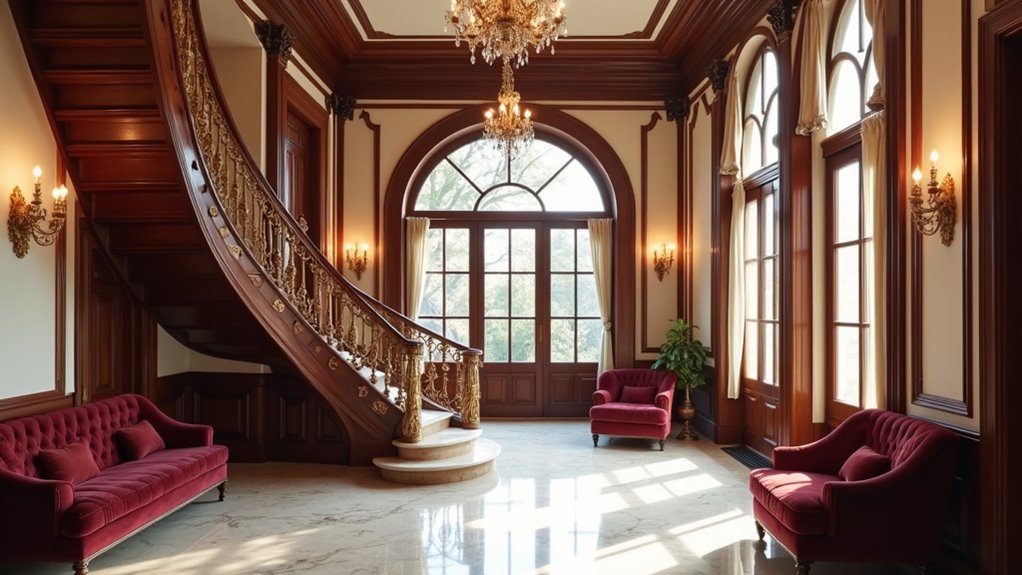Colonial house interiors captivate with timeless elegance and precision. Embrace symmetry through central hallways and balanced furniture layouts for visual harmony. High ceilings paired with large windows invite natural light, enhancing spaciousness. Intricate moldings and wainscoting, like raised oak panels, add architectural depth. Neutral tones blend with tropical accents via rattan textures and vibrant hues. Mixing antique mahogany with modern pieces creates dynamic charm. Explore further to uncover deeper insights into these stunning designs.
Key Takeaways
- Embrace symmetry with a central hallway and balanced furniture for a harmonious colonial aesthetic.
- Use high ceilings and large windows to enhance spaciousness and natural light.
- Add elegance with crown molding and raised panel wainscoting for traditional depth.
- Incorporate neutral tones with tropical accents like rattan and botanical prints for warmth.
- Mix antique and modern furniture using the 80/20 rule for a dynamic look.
Embracing Symmetry and Balance in Your Layout
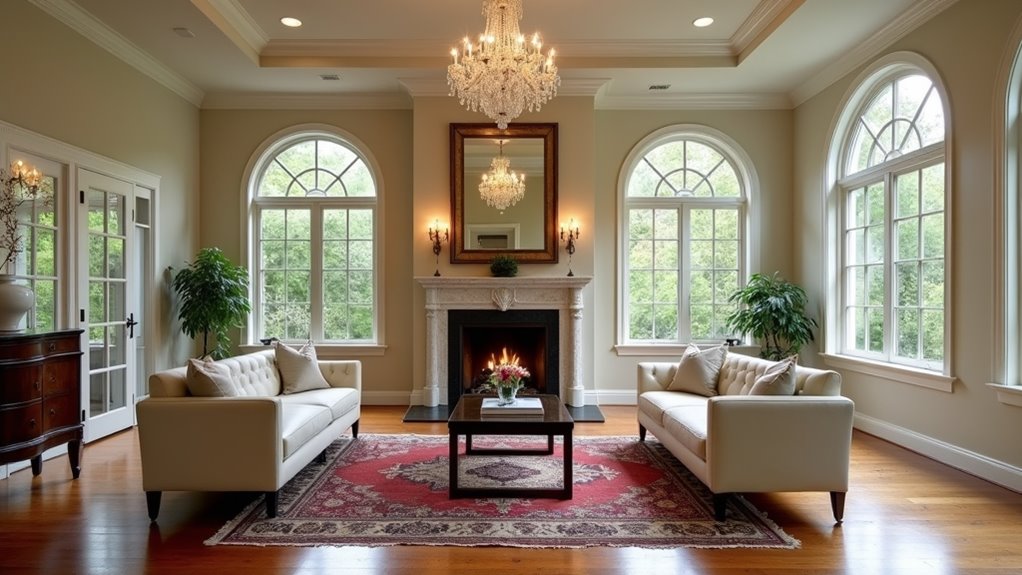
Symmetry, a cornerstone of colonial house design, anchors the aesthetic with its precise balance and orderly charm. This principle manifests in the geometric layout of colonial homes, where a central hallway often acts as the spine, dividing spaces with meticulous precision.
Rooms branching off this axis are crafted with an eye for harmony, ensuring an even distribution of visual weight through a focal point arrangement, such as a fireplace anchoring the space. This central hallway layout not only organizes the home but also reflects the historical design roots of early American architecture, emphasizing functionality alongside elegance.
Interior design echoes this balance through balanced furniture placement, where pairs of chairs or heirloom cabinets flank key elements, creating a refined order. Hardwood flooring, a hallmark of colonial interiors, adds warmth and authenticity to these balanced spaces, enhancing the traditional allure with its timeless material charm.
The understated luxury of colonial style shines in these deliberate choices, with furniture proportions mirroring the home’s rectangular facade. Clean lines and symmetrical seating arrangements reinforce the disciplined elegance, transforming interiors into serene, harmonious retreats that honor tradition while maintaining a timeless appeal through calculated spatial equilibrium.
Incorporating High Ceilings and Large Windows
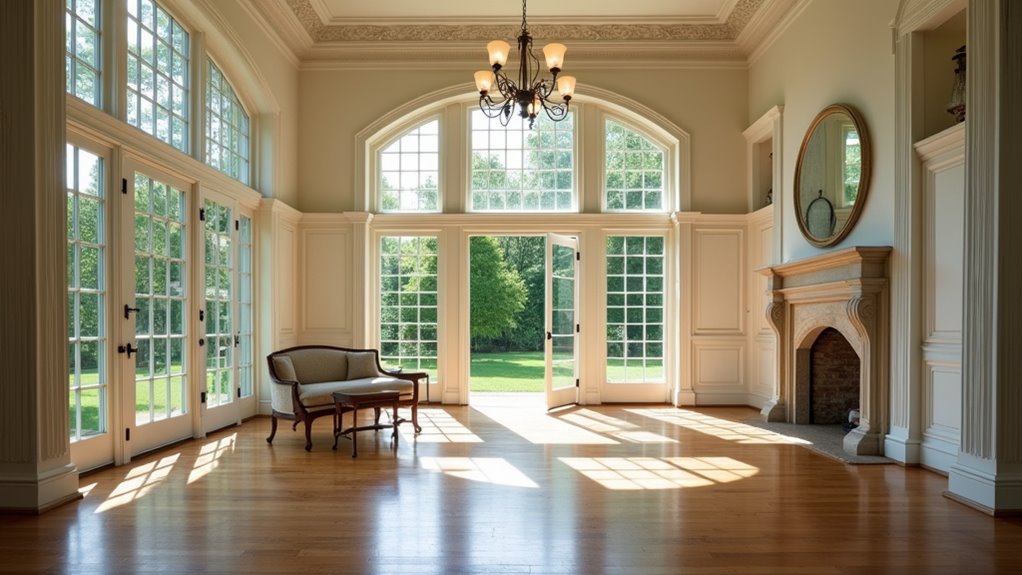
Beyond the disciplined harmony of balanced layouts, colonial house design also captivates with its soaring high ceilings and expansive windows, which elevate both form and function. These elements infuse interiors with grandeur, leveraging vertical space to enhance airiness and natural ventilation, a nod to historical needs for airflow in warmer climates. High ceilings showcase architectural details like exposed beams, while large windows—often double-hung or casement—flood rooms with light, connecting spaces to the outdoors.
Strategically placed windows and open layouts maximize daylight, supported by modern energy-efficient glazing. The table below highlights key design considerations:
| Feature | Benefit |
|---|---|
| High Ceilings | Enhanced spaciousness and cooling |
| Large Windows | Ample natural light and views |
| South-Facing Orientation | Optimal passive solar heating |
| Neutral Wall Colors | Reflects light for brighter spaces |
Such meticulous integration ensures both aesthetic allure and practical comfort in colonial interiors.
Enhancing Elegance With Moldings and Wainscoting
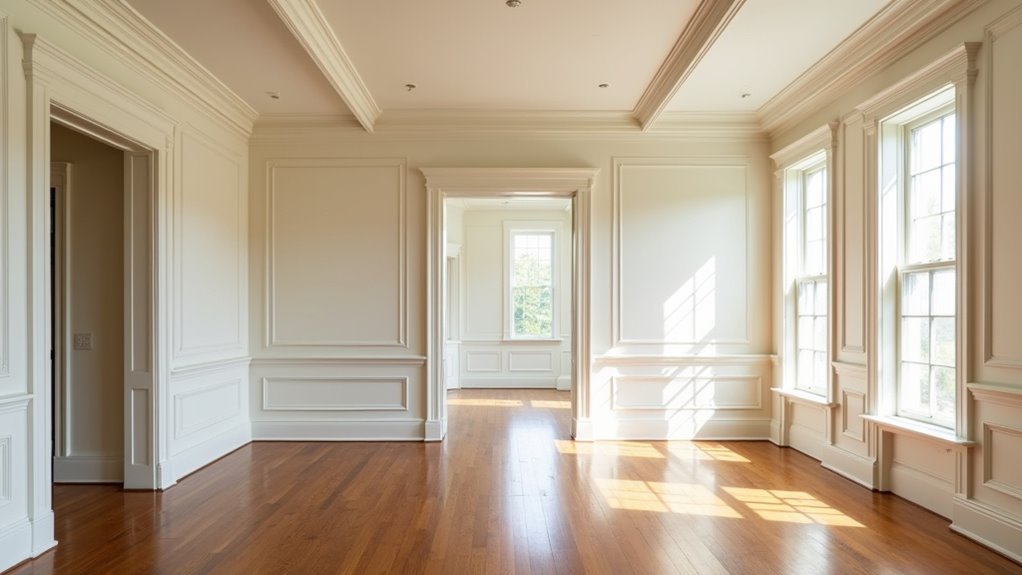
While high ceilings and expansive windows define the grandeur of colonial interiors, the refined elegance of moldings and wainscoting introduces a layer of historical depth and architectural sophistication.
These elements, with their intricate molding profiles and diverse wainscoting styles, frame spaces with timeless charm, accentuating walls and transitions with precision.
To elevate colonial interiors, consider these sophisticated applications:
- Crown Molding: Employ cyma recta profiles for a Roman-inspired arch at ceiling junctures.
- Raised Panel Wainscoting: Install at 30-40 inches high for traditional beveled depth.
- Chair Rail: Use cyma reversa molding profiles to protect walls with historical flair.
- Beadboard Wainscoting: Opt for grooved vertical planks in informal areas for subtle texture.
- Wood Materials: Choose oak or pine for warmth in both moldings and wainscoting styles.
Such details transform plain surfaces into canvases of heritage, balancing formality and craftsmanship in every corner of a colonial home.
Blending Neutral Tones With Tropical Accents
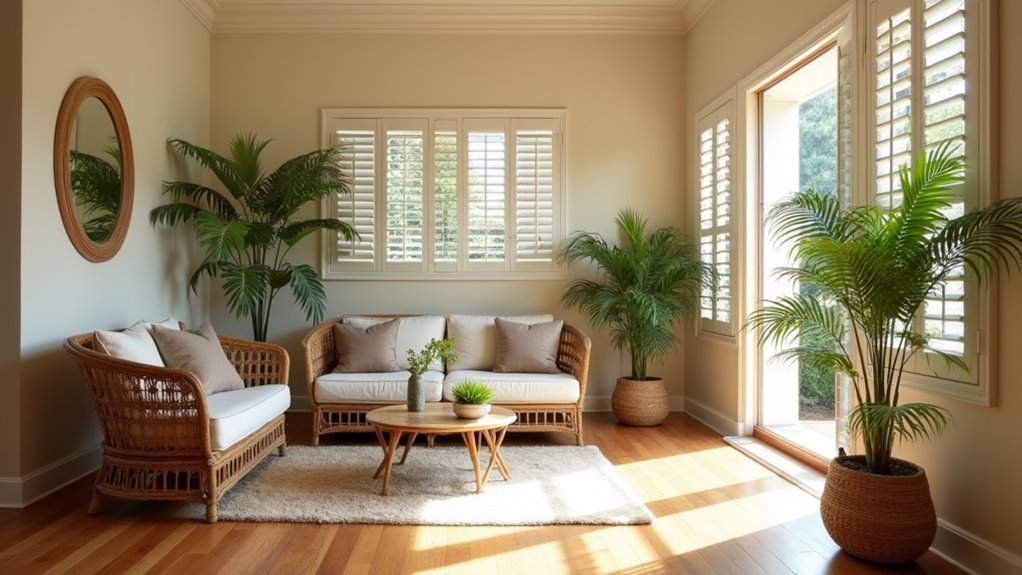
As colonial interiors embrace historical elegance, the integration of neutral tones with tropical accents offers a harmonious blend of sophistication and exotic warmth. A foundation of neutral accents, such as walls painted in warm whites like “White Dove” or soft taupe, creates an airy backdrop that accentuates dark mahogany furniture.
These calming neutrals allow vibrant tropical hues—think muted greens, turquoise, or coral—to shine through in accessories and textiles, evoking an exotic yet refined ambiance.
Vibrant tropical hues like muted greens and turquoise emerge in accessories, crafting an exotic yet polished ambiance against calming neutral tones.
Layering natural textures like rattan rugs or linen cushions enhances depth, while lush indoor palms and botanical prints in subdued greens introduce a tropical essence without overpowering the space.
Plantation shutters and light hardwood floors maintain an open feel, balancing formality with relaxed charm. Strategically placed pops of tropical hues in cushions or artwork ensure a cohesive design, merging colonial restraint with the lively spirit of the tropics.
Mixing Antique and Modern Furniture Styles
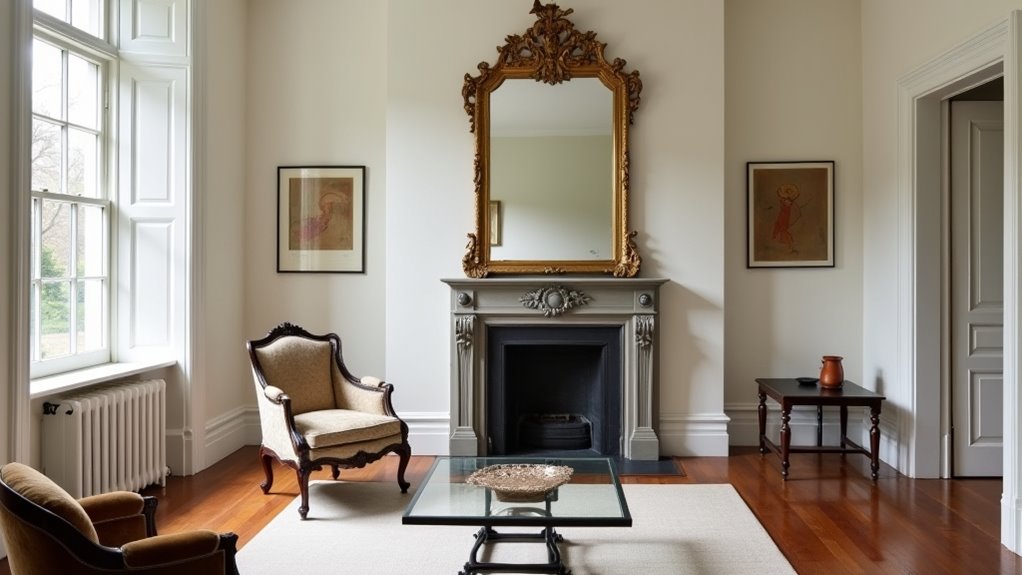
Creating a colonial interior that feels both timeless and fresh often involves skillfully mixing antique and modern furniture styles, a natural progression from the interplay of neutral tones and tropical accents.
This approach juxtaposes antique textures with modern contrasts, crafting a dynamic yet cohesive aesthetic. Designers can achieve balance by adhering to the 80/20 rule, ensuring one style dominates while the other adds intrigue, and by harmonizing materials like dark mahogany with light cotton upholstery.
To refine this blend, consider these sophisticated strategies:
- Pair an antique wooden dresser with a sleek modern sofa for visual tension.
- Place a contemporary light fixture on an aged desk for striking contrast.
- Combine a classic dining table with minimalist chairs for elegance.
- Reupholster vintage armchairs with bold, current fabrics to refresh their appeal.
- Distribute pieces evenly across the space to maintain a unified look.
This meticulous integration elevates colonial interiors with timeless sophistication.
